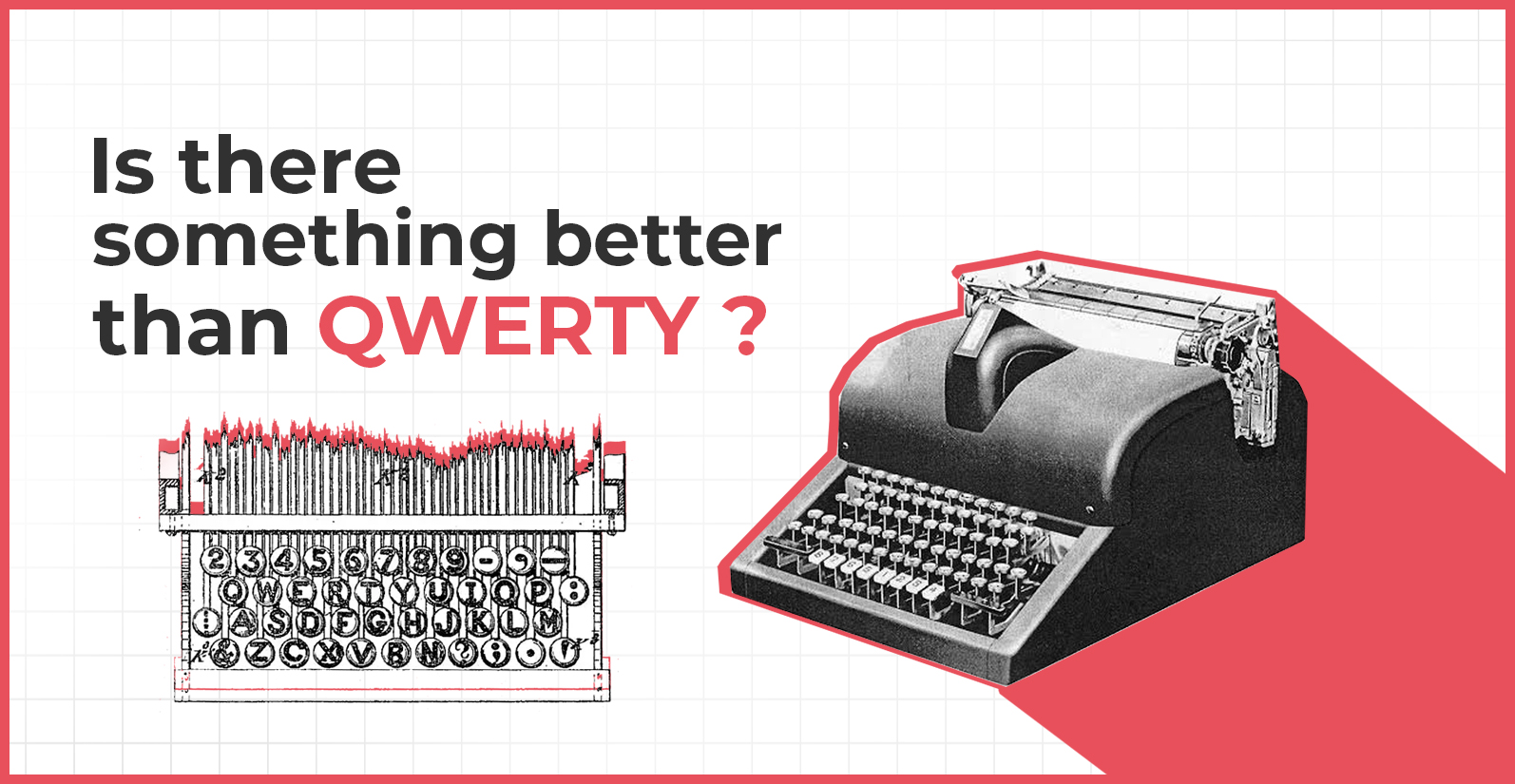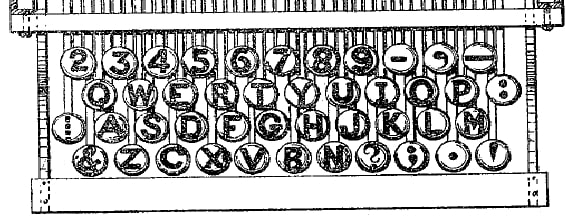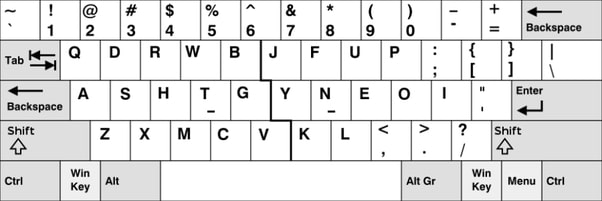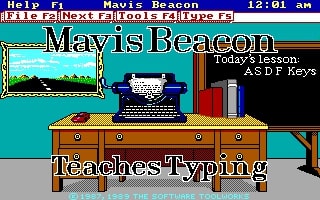
The First Design
The history of the keyboard is a bit foggy, but it’s said that the typewriter was first invented in the early 1800s. And, the earliest keyboard was laid out in alphabetic order. Oddly, the keys were organized like a piano.

The layout may have been excellent for pianists but nobody else. I mean all typing systems, aside from hunting-and-pecking, require training, but the piano-like layout was simply awkward, plus, it had mechanical issues. This layout was created and patented by Christopher Latham Sholes.
Who Was this Nan who Fearlessly Experimented with Keyboard Layouts
Christopher Latham Sholes was a politician, printer, journalist and an inventor from Milwaukee. Most notably, he invented the QWERTY keyboard layout, though there were others, the piano-like keypad in the first example and what is referred to as “Sholes Final Keyboard Layout.” There’s little documentation about it, all I can say is that QWERTY was flawed, especially when compared to DVORAK, and so, Sholes created his “final” to compete with the speeds typists achieved on the DVORAK layout. Sholes final keyboard was never taken on by a typewriter manufacturer and only a keymap in technology archives exists. Here it is:

For some reason, the layout included a vertical ellipses, a symbol with a Unicode but seemingly no practical use. During the industrial revolution, including a key for the horizontal ellipsis would’ve made sense, writers called these 3 dots the “the quad space.” I can’t remember the writer’s name, but I remember a quote that read “due to the prudishness of the era all good things happened in the quad space.” But I digress, Sholes “final” looks no less cumbersome than the QWERTY layout.
A Bit of History
Why did Sholes create such a clunky layout? On layouts that placed the most often used letters close together, the keys got jammed and typist had to stop to un-jam them – manually. Sholes design came from a mechanical necessity. In fact, QWERTY beta-testers included telegraph operators who needed to quickly transcribe messages, stuck keys wouldn’t have been ideal.

Yet, especially in modern times when keyboard mechanics have been laid to waste by character maps buried deep in your X11 config files, QWERTY isn't the most User friendly keyboard. To be more specific, “70% of words in English can be typed with the letters DHIATENSOR, yet only 4 of those 10 letters fall on QWERTY’s home-row(Mental Floss).”
Everything Evolves

Back in the 1920’s, the Noiseless Typewriter Company created a silent typewriter to combat what was coined as “Stenographer’s Face,” supposedly, the clickity-clack-clack of the typing-pool sped-up the aging process. Nowadays, typing is processed in binary code, my point is typewriter technology moves on, so why do we stick with something as flawed as QWERTY?
Introducing Dvorak
August Dvorak was an American psychologist and professor. One day, Dr. Dvorak had an epiphany, only 32% of typing was done on the home-row keys of the QWERTY keyboard. And so, he created an alternate layout that reduced the finger movement associated with typing. It increased speed and decreased errors.
According to the scholar Kathryn Hempstalk “Dvorak trained Typists at the Navy base where he worked and sent [them] around to typing competitions. These typists were so successful that the Dvorak layout was eventually barred from all [typing] competitions. Even today, the fastest known typing speed was recorded in the 1940’s using the Dvorak Layout—212 words per minute.”

How do typist move so fast with the DVORAK layout? Seventy percent of typing is done on the home-row. Less finger movement means less strain this ergonomics, something Sholes’ layout failed at.
Introducing Colemak
The Colemak keyboard is a recent re-engineering of the QWERTY layout. And, it’s quickly attracting Users. Unlike Dvorak, who created his layout from scratch, the developers of Colemak altered the QWERTY keyboard, making small improvements and addressing the weaknesses of Sholes’ design. The keyboard retains some familiar key positions, making it easier for newcomers.

On the Colemak layout, 74% of typing is done on the home row. This is a 4% improvement over the DVORAK layout and heaps above QWERTY.
Introducing Workman
The Workman keyboard layout was developed even more recently that Colemak. It focuses on software programming. The Workman layout was made to address one of the most frequent criticisms of Colemak, placement of the H and E keys. They are inconveniently located on the Workman layout.

As stated by Kenisis.com “the objective of the Workman layout was to position the most commonly used letters within the natural range of motion of the fingers, rather than exclusively the home-row, which is pretty intuitive.” Again, this is the kind of ergonomics QWERTY doesn’t come close to.
Conclusion
I guess the evolution of the typewriter parallels that of pianos: a shift from the harpsichord, a keyed instrument with obvious flaws (it could only be played in one dynamic – loud) to the less than perfect pianoforte (what, in the parlance of our times we simply refer to as the piano). Yet unlike those during the 1700’s, we, for the most part, refuse to adapt to something better. About 70% of words in English can be hammered-out with the letters DHIATENSOR, only 4 of those 10 letters are in QWERTY’s home-row. On QWERTY’s layout, “the letter A falls on the home-row(the only vowel to do so), but it must be struck with what is for most typists the weakest finger — the left pinky Mental Floss).”
Besides the few keyboard layouts I’ve mentioned, there’s dozens more, you can find 13 of them here. And, you may, if you don’t fear coding, alter your keyboard maps or make a layout with Python. To make your own custom keyboard you can either:
- Use a python script
- Try to use key Mapper
- Manually edit the your xkb file
Finally, if you want to revisit retro teach-yourself-to-type software. The Internet Archive has a copy of Mavis Beacon Teaches Typing,for the Apple II. Run this gem in an emulator and relive the days of two-tone monitors.

In the end, QWERTY is the weakest chain in the link and it seems that we only use it because keyboard manufacturers stick with this haggardly old layout.
